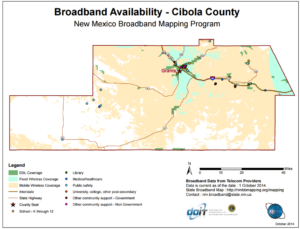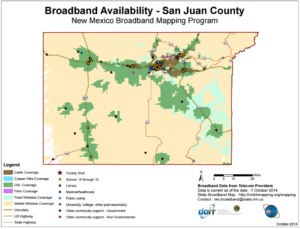Welcome to the first Digital Inclusion Corps Field Report. In this column, we’ll hear from different members of our Digital Inclusion Corps pilot team. If you’re interested in learning more about the projects, check out the page.
Our first column comes from Drew Lauderdale our Corps member in New Mexico, hosted at the Explora Science Center & Children’s Museum in Albuquerque.
 Hi, my name is Drew Lauderdale. Though I am not a native of New Mexico, it is my adopted home, and I am proud to be included in the NDIA Pilot Corps. I work currently with Explora Science Center located in Albuquerque, which with its dynamic staff and culture of generosity, is known throughout the state. I would like to share a small part of the two weeks I have spent so far as a Digital Inclusion Pilot Corps member, and some of how I am piecing together the threads of digital inclusion in beautiful New Mexico.
Hi, my name is Drew Lauderdale. Though I am not a native of New Mexico, it is my adopted home, and I am proud to be included in the NDIA Pilot Corps. I work currently with Explora Science Center located in Albuquerque, which with its dynamic staff and culture of generosity, is known throughout the state. I would like to share a small part of the two weeks I have spent so far as a Digital Inclusion Pilot Corps member, and some of how I am piecing together the threads of digital inclusion in beautiful New Mexico.
As a start to the NDIA Pilot Corps Project in New Mexico I began looking over maps and census data extensively as a groundwork for my project narrative. It became clear early on that my focus areas in the state of New Mexico should be concentrated in the northwest corner. The three counties that fall within this zone are San Juan county to the north, McKinley to the south, and only a small portion of Cibola county as well, south of McKinley.
 As you can see from the maps provided the cultural makeup of the Northwest focus zone is primarily Navajo living mainly in the Navajo Nation as well as the Ramah reservation, but also includes the Zuni Pueblo in Cibola county. There are two main urban centers in these three counties, Gallup, and Farmington. Libraries, health centers, banks, and institutes of higher education are clustered in these two urban areas; with the notable exception of Navajo Technical Institute, located in Crownpoint NM.
As you can see from the maps provided the cultural makeup of the Northwest focus zone is primarily Navajo living mainly in the Navajo Nation as well as the Ramah reservation, but also includes the Zuni Pueblo in Cibola county. There are two main urban centers in these three counties, Gallup, and Farmington. Libraries, health centers, banks, and institutes of higher education are clustered in these two urban areas; with the notable exception of Navajo Technical Institute, located in Crownpoint NM.
The population of the Zuni Pueblo is concentrated on one urban center, Zuni, which is a concentration point for private and governmental services. The population within the Navajo Nation and Ramah Navajo, however, is far from clustered, providing a challenge for digital access to families that do not own a home computer or are outside the narrow range of broadband connection. It is this challenge to access of digital resources that I am researching now. Recently I had the pleasure of meeting Alana McGrattan and Jean Whitehorse who work with the Tribal Libraries Program through the New Mexico State Library who are currently tackling the problems of access in tribal lands all across New Mexico.
 Jean Whitehorse for many years has been engaged in digital literacy training with seniors in the Navajo Nation all across New Mexico, making use of Chapter Houses (civic-governmental centers common in Navajo land) as community stakeholders to host her classes, as well as other locations as opportunity arises. Her knowledge of the local culture and ability to communicate allegorically to her students has made her a successful digital educator, one who I very much hope to work with in the course of this pilot project. To tackle the problem of access I also spoke with Alana McGrattan, who is the Tribal Libraries Program Coordinator. Most notably for this project, Alana has implemented a pilot program organized by New Mexico State Library in collaboration with T-Mobile to check out mobile hotspots from the Silver City Public Library in New Mexico. Just as I hope to work with Jean Whitehorse I am also excited to work with Alana McGrattan.
Jean Whitehorse for many years has been engaged in digital literacy training with seniors in the Navajo Nation all across New Mexico, making use of Chapter Houses (civic-governmental centers common in Navajo land) as community stakeholders to host her classes, as well as other locations as opportunity arises. Her knowledge of the local culture and ability to communicate allegorically to her students has made her a successful digital educator, one who I very much hope to work with in the course of this pilot project. To tackle the problem of access I also spoke with Alana McGrattan, who is the Tribal Libraries Program Coordinator. Most notably for this project, Alana has implemented a pilot program organized by New Mexico State Library in collaboration with T-Mobile to check out mobile hotspots from the Silver City Public Library in New Mexico. Just as I hope to work with Jean Whitehorse I am also excited to work with Alana McGrattan.
 In two weeks time I will mention other community stakeholders that I have contacted and are doing the work of digital inclusion all across New Mexico, but for now I will leave you with the links for the New Mexico Tribal Libraries Program, and for the New Mexico Department of Information Technology, who has made available most of the maps I have used in the early stage of this pilot project.
In two weeks time I will mention other community stakeholders that I have contacted and are doing the work of digital inclusion all across New Mexico, but for now I will leave you with the links for the New Mexico Tribal Libraries Program, and for the New Mexico Department of Information Technology, who has made available most of the maps I have used in the early stage of this pilot project.
http://www.nmstatelibrary.org/services-for-nm-libraries/programs-services/tribal-libraries-program
